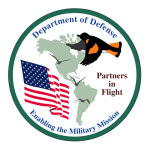The international Partners in Flight (PIF) initiative was initiated in 1990 in response to declining populations of migratory birds. PIF comprises a cooperative partnership among federal, state, and local government agencies, philanthropic foundations, professional organizations, conservation groups, industry, the academic community, and private individuals across the Americas. The initiative focuses resources on improving monitoring and inventory, research, management, and education programs involving birds and their habitats. PIF’s mission has three priorities: keeping common birds common, helping bird species at risk, and fostering voluntary partnerships that benefit birds, habitats, and people.
In 1991, the Department of Defense signed a Memorandum of Agreement (MOA) with other federal agencies to participate in Partners in Flight to help actively manage its natural resources and support mission needs and flight safety goals, while pursuing a sound conservation ethic that strives to benefit bird species throughout the Americas. Jacqueline Schafer, Assistant Secretary of the Navy (Installations and Environment), was the first DoD signatory to the MOA, on May 14, 1991. Ms. Schafer assigned a liaison to the MOA. This established the Navy as the Executive Agent for DoD regarding migratory bird issues. The Air Force signed an addendum to the MOA on October 31, 1991, and the Army signed an addendum shortly thereafter.
The Navy liaison and DoD PIF Coordinator, Joe Hautzenroder, assembled a network of DoD biologists to begin development on of first strategic plan for migratory birds by any federal agency. A full-time Program Manager, Chris Eberly, was hired in 1997. Chris later became the National Technical Representative.
The DoD Partners in Flight program is among the most active federal agencies in the international PIF program. The DoD PIF network represents DoD at state, regional, national and international meetings and provides military natural resources professionals with the most up-to-date information on bird conservation planning.

